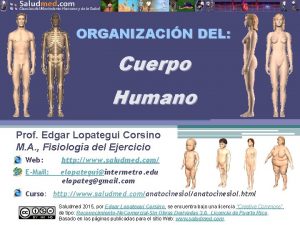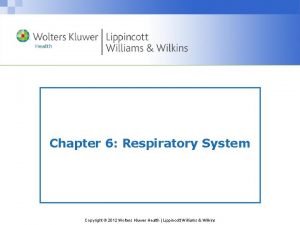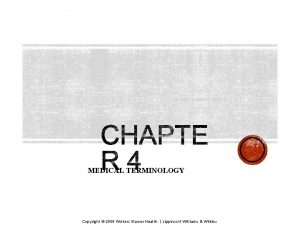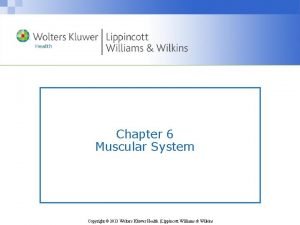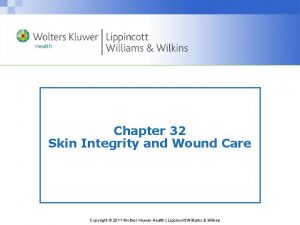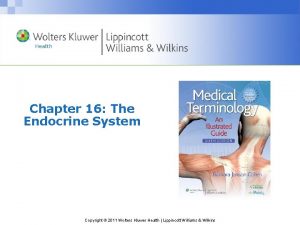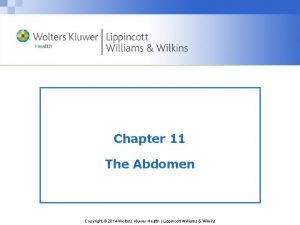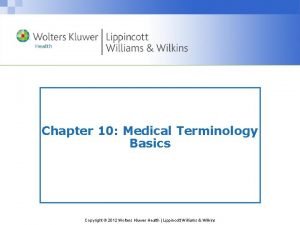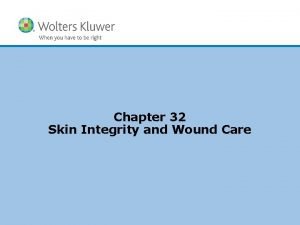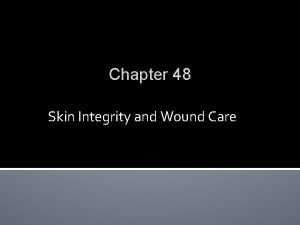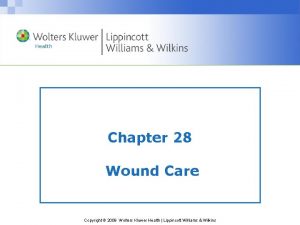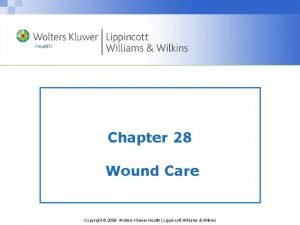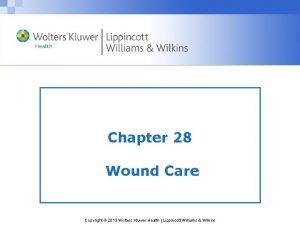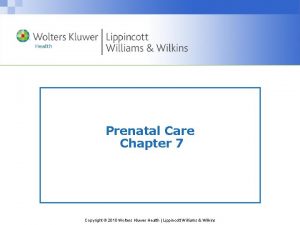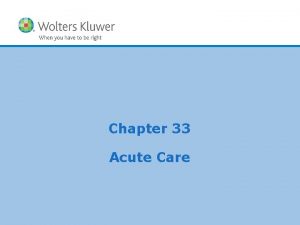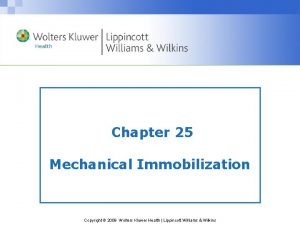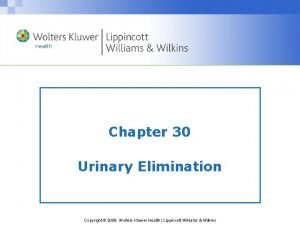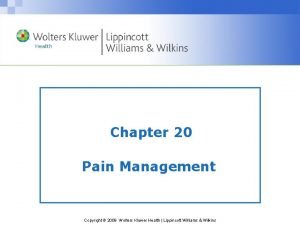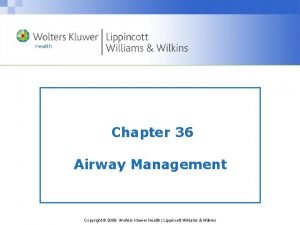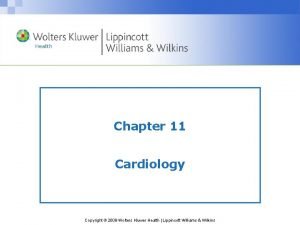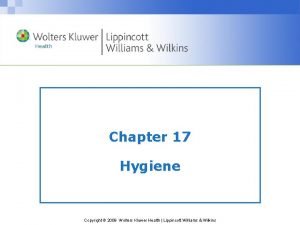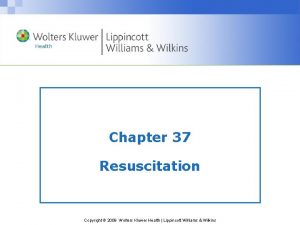Chapter 28 Wound Care Copyright 2009 Wolters Kluwer


























- Slides: 26

Chapter 28 Wound Care Copyright © 2009 Wolters Kluwer Health | Lippincott Williams & Wilkins

Wounds • Wound: damaged skin or soft tissue resulting from trauma – Open wounds: mucous membrane is no longer intact – Closed wounds: no open mucous membrane Copyright © 2009 Wolters Kluwer Health | Lippincott Williams & Wilkins

Wound Repair • Inflammation: physiologic defense occurring immediately after tissue injury, lasting 2 to 5 days – Purpose: limit local damage, remove injured cells/debris, prepare wound for healing – Signs and symptoms of inflammation: swelling, redness, warmth, pain, and decreased function Copyright © 2009 Wolters Kluwer Health | Lippincott Williams & Wilkins

Copyright © 2009 Wolters Kluwer Health | Lippincott Williams & Wilkins

Wound Repair (cont’d) • Proliferation: period during which new cells fill and seal a wound; it occurs 2 days to 3 weeks after inflammatory phase – The integrity of skin and damaged tissue is restored by resolution, regeneration, and scar formation Copyright © 2009 Wolters Kluwer Health | Lippincott Williams & Wilkins

Wound Repair (cont’d) • Remodeling: period during which the wound undergoes changes and maturation – Lasts 6 months to 2 years – During remodeling, the wound contracts and the scar shrinks Copyright © 2009 Wolters Kluwer Health | Lippincott Williams & Wilkins

The Inflammatory Response Copyright © 2009 Wolters Kluwer Health | Lippincott Williams & Wilkins

Copyright © 2009 Wolters Kluwer Health | Lippincott Williams & Wilkins

Wound Healing • First-intention healing: reparative process in which wound edges are directly next to each other • Second-intention healing: wound edges are widely separated; time-consuming, complex reparative process • Third-intention healing: deep wound edges brought together with some type of closure material, resulting in a broad, deep scar Copyright © 2009 Wolters Kluwer Health | Lippincott Williams & Wilkins

Wound Healing Factors • Type of wound injury • Expanse or depth of wound • Circulation quality • Amount of wound debris • Presence of infection • Client’s health status Copyright © 2009 Wolters Kluwer Health | Lippincott Williams & Wilkins

Wound Repair Copyright © 2009 Wolters Kluwer Health | Lippincott Williams & Wilkins

Wound Healing Complications • Wound healing key: adequate blood flow to the injured tissue • Interfering factors may include: – Compromised circulation – Infection – Purulent, bloody, or serous fluid accumulation preventing skin and tissue approximation Copyright © 2009 Wolters Kluwer Health | Lippincott Williams & Wilkins

Wound Healing Complications (cont’d) • Potential surgical wound complications – Dehiscence: separation of wound edges – Evisceration: wound separation with protrusion of organs Copyright © 2009 Wolters Kluwer Health | Lippincott Williams & Wilkins

Dressings • Dressing purposes: – Keeping wound clean – Absorbing drainage – Controlling bleeding – Protecting wound from further injury – Holding medication in place – Maintaining a moist environment Copyright © 2009 Wolters Kluwer Health | Lippincott Williams & Wilkins

Dressings (cont’d) • Types of dressings: – Gauze dressings: ideal for covering fresh wounds that are likely to bleed, or wounds that exude drainage – Transparent dressings: used to cover peripheral and central IV insertion sites Copyright © 2009 Wolters Kluwer Health | Lippincott Williams & Wilkins

Dressings (cont’d) • Types of dressings (cont’d) – Hydrocolloid dressings: keep wounds moist; moist wounds heal more quickly; new cells grow more rapidly in a wet environment – Dressing changes: when a wound requires assessment or care Copyright © 2009 Wolters Kluwer Health | Lippincott Williams & Wilkins

Wound Management • Drains – Open drains – Closed drains • Sutures and staples Copyright © 2009 Wolters Kluwer Health | Lippincott Williams & Wilkins

Wound Management (cont’d) • Bandages and binders – Purpose: hold dressings in place, especially if tape cannot be used or dressing is very large – Support area around the wound or injury to reduce pain – Limit movement in wound area to promote healing Copyright © 2009 Wolters Kluwer Health | Lippincott Williams & Wilkins

Wound Management (cont’d) • Roller bandage application • Binder application – Different types of binders o Single T-binder o Double T-binder Copyright © 2009 Wolters Kluwer Health | Lippincott Williams & Wilkins

Wound Management (cont’d) • Debridement: removal of dead tissue – Sharp debridement: using sterile scissors, forceps, etc. – Enzymatic debridement: using chemical substances – Autolytic debridement: natural physiologic process Copyright © 2009 Wolters Kluwer Health | Lippincott Williams & Wilkins

Wound Management (cont’d) • Debridement (cont’d): – Mechanical debridement: physical removal of debris from a wound using wet-to-dry dressings, hydrotherapy, irrigation o Commonly irrigated structures include: § Wounds, eyes, ears, vagina Copyright © 2009 Wolters Kluwer Health | Lippincott Williams & Wilkins

Wound Management (cont’d) • Heat and cold applications – Ice bag and ice collar – Chemical packs – Compresses – Aquathermia pad – Soaks and moist packs – Therapeutic baths Copyright © 2009 Wolters Kluwer Health | Lippincott Williams & Wilkins

Pressure Ulcers • Also known as decubitus ulcers – Appear over bony prominences of the sacrum, hips, heals, and places where pressure is unrelieved • Risk factors include: − Inactivity, immobility, malnutrition, emaciation − Diaphoresis, incontinence, sedation − Vascular disease, localized edema, dehydration Copyright © 2009 Wolters Kluwer Health | Lippincott Williams & Wilkins

Pressure Ulcers (cont’d) • Stages of pressure ulcers – Stage I: intact but reddened skin – Stage II: reddened skin accompanied by blistering or a skin tear – Stage III: shallow skin crater that extends to the subcutaneous tissue – Stage IV: deeply ulcerated, extending to muscle and bone; life threatening Copyright © 2009 Wolters Kluwer Health | Lippincott Williams & Wilkins

Pressure Ulcers (cont’d) • Prevention of pressure ulcers – Change client’s position frequently – Avoid using plastic-covered pillows – Use the lateral position for side-lying – Massage bony prominences – Use pressure-relieving devices – Provide a balanced diet and adequate fluid intake Copyright © 2009 Wolters Kluwer Health | Lippincott Williams & Wilkins

Nursing Implications • Potential nursing diagnoses: – Acute pain – Impaired skin and tissue integrity – Ineffective tissue perfusion – Risk for infection Copyright © 2009 Wolters Kluwer Health | Lippincott Williams & Wilkins
 Wolters kluwer health
Wolters kluwer health Wolters kluwer health
Wolters kluwer health Wolters kluwer
Wolters kluwer Wolters kluwer
Wolters kluwer Lippincott williams & wilkins
Lippincott williams & wilkins Wolters kluwer health
Wolters kluwer health Wolters kluwer
Wolters kluwer Exercise physiology for health, fitness, and performance
Exercise physiology for health, fitness, and performance Wolters kluwer
Wolters kluwer Wolters kluwer
Wolters kluwer Wolters kluwer health
Wolters kluwer health Wolters kluwer
Wolters kluwer Wolters kluwer health
Wolters kluwer health Wolters kluwer
Wolters kluwer Wolters kluwer
Wolters kluwer Wolters kluwer pronunciation
Wolters kluwer pronunciation Wolters kluwer
Wolters kluwer Wolters kluwer
Wolters kluwer Wolters kluwer
Wolters kluwer Wolters kluwer
Wolters kluwer Physical examination techniques
Physical examination techniques Wolters kluwer ovid
Wolters kluwer ovid Wolters kluwer health lippincott williams & wilkins
Wolters kluwer health lippincott williams & wilkins Wolters kluwer culture
Wolters kluwer culture Wolters kluwer pronunciation
Wolters kluwer pronunciation Serosanguineous vs serous
Serosanguineous vs serous Chapter 48 skin integrity and wound care
Chapter 48 skin integrity and wound care


